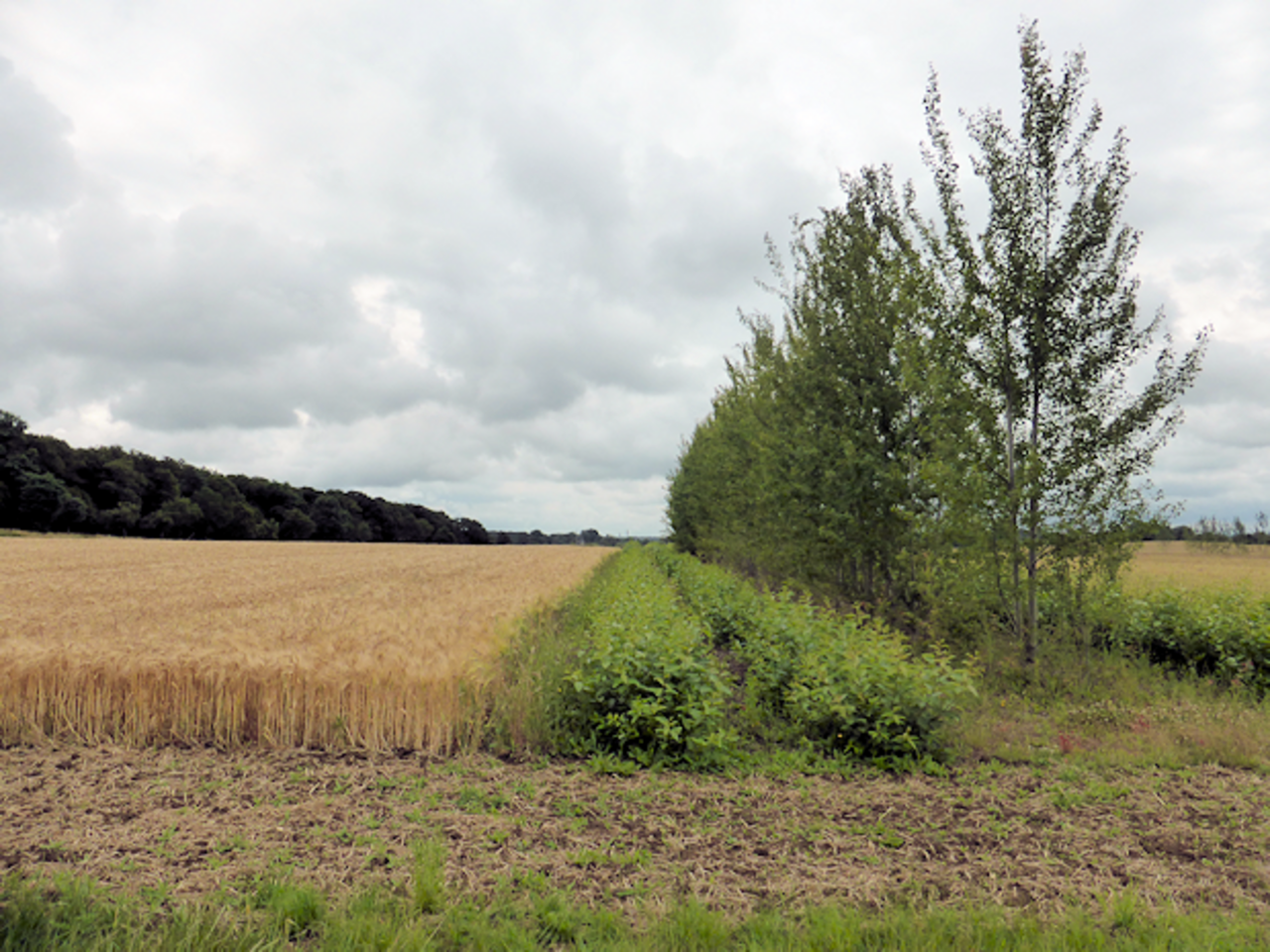Project
Short rotation agroforestry systems

Sustainable provision of woody biomass for energy production in agroforestry systems
We investigate alley-cropping systems which combine the production of woody biomass as energy feedstock with conventional field crops in Germany. The aim is an ecological assessment of this novel land-use type.
Background and Objective
Agroforestry describes the simultaneous production of trees and crops on one field. That means a spatial combination of forestry and agricultural elements. The aim is to achieve economic and / or ecological additional value by using synergy between trees and crops. A modern form of agroforestry systems are strips of fast growing trees like poplar and willow on agricultural area. The implementation of short rotation coppice (SRC) strips on cropland as agroforestry systems may result in positive effects for close-by crops as well as for the environment. Essential for optimal success is a thoughtful planning of the structure.
The aim of our project is to investigate whether, depending on the conditions of the respective fields, SRC strips can be used to generate wind shelter or reduce water erosion, whether the SRC strips facilitate soil regeneration and carbon storage and whether flora and fauna take advantage from the low-input and structurally diverse agroforestry system.
Approach
Within workpackage 3.2, we are studying the significance of poplar strips for the conservation and promotion of functional aspects of biodiversity within the agroforestry system.
Research objectives:
- Assessment of indicators of ecosystem services within the agroforestry system in comparison to conventional farming systems
- Aphid infestation and parasitation rates
- Predation rates for insect prey and weed seeds by generalist predatory arthropods
- Mineralization of organic material in soil (bait-lamina-test)
- Soil formation (activity of earthworms)
- Quantification of the exchange of epigeic arthropods between the poplar and the field strips in spring (recolonisation of arable fields) and autumn (seeking for hibernation habitat).
- Assessment of spatio-temporal dynamics of pests (aphids) and their natural enemies (epigeic arthropods and parasitoids) in field strips
- Comparing the diversity, community composition and activity of pests and their natural enemies in poplar strips and seminatural habitats
- Indicator based estimation of the economic value and costs generated by ecosystem services and dis-services respectively within the agroforestry system
Results
Justine Lamerre, Maren Langhof, Kati Sevke-Masur, Kai-Uwe Schwarz, Georg von Wühlisch, Anita Swieter, Jörg Michael Greef, Jens Dauber, Felix Hirschberg, Ineke Joormann, Naemi Krestel, Daniel Masur, Christopher Reith (2016) Nachhaltige Erzeugung von Energieholz in Agroforstsystemen, Teilprojekt 3: Standort Niedersachsen; Strukturvielfalt und Biodiversität. Schlussbericht (FKZ 22000412). Braunschweig, Julius Kühn-Institut und Johann Heinrich von Thünen-Institut. 166 S. http://www.fnr-server.de//ftp/pdf/berichte/22000412.pdf
Links and Downloads
Thünen-Contact

Involved external Thünen-Partners
- Julius Kühn-Institut - Bundesforschungsinstitut für Kulturpflanzen (JKI)
(Quedlinburg, Braunschweig, Groß Lüsewitz, Kleinmachnow, Deutschland) - Brandenburgische Technische Universität (BTU)
(Cottbus , Deutschland) -
Thüringer Landesanstalt für Landwirtschaft
(Jena, Deutschland)
Funding Body
-
Fachagentur Nachwachsende Rohstoffe e.V. (FNR)
(national, öffentlich)
Duration
4.2012 - 8.2015
More Information
Project funding number: 22000412
Project status:
finished
Publications
- 0
Dauber J, Baum S, Masur D, Sevke-Masur K, Glemnitz M (2018) Agrarholzanbau und Biodiversität. In: Veste M, Böhm C (eds) Agrarholz - Schnellwachsende Bäume in der Landwirtschaft : Biologie - Ökologie - Management. Wiesbaden: Springer Spektrum, pp 391-432
- 1
Lamerre J, Langhof M, Sevke-Masur K, Schwarz KU, Wühlisch G von, Swieter A, Greef JM, Dauber J, Hirschberg F, Joormann I, Krestel NT, Masur D, Reith C (2016) Schlussbericht zum Vorhaben : Thema: Nachhaltige Erzeugung von Energieholz in Agroforstsystemen, Teilprojekt 3: Standort Niedersachsen; Strukturvielfalt und Biodiversität ; Laufzeit: 1. April 2012 - 31. August 2015. Berlin: Bundesministerium für Ernährung und Landwirtschaft (BMEL), 171 p
- 2
Dauber J, Miyake S (2016) To integrate or to segregate food crop and energy crop cultivation at the landscape scale? Perspectives on biodiversity conservation in agriculture in Europe. Energy Sustain Soc 6:25, DOI:10.1186/s13705-016-0089-5
- 3
Masur D, Bärwolff M, Jung L, Dauber J (2015) Die Rolle verschiedener Energiegehölzarten für funktionale Biodiversität in Kurzumtriebs-Agroforstsystemen. Mitt Gesellsch Pflanzenbauwiss 27:81-82
- 4
Dauber J, Bolte A (2014) Bioenergy: Challenge or support for the conservation of biodiversity? GCB Bioenergy 6(6):180-182, DOI:10.1111/gcbb.12188
- 5
Masur D, Hirschberg F, Lamerre J, Dauber J (2013) SRC-alley cropping: an integrative measure to sustain biodiversity and ecosystem services in agricultural landscapes? Mitt Gesellsch Pflanzenbauwiss 25:190
- 6
Dauber J, Brown C, Fernando AL, Finnan J, Krasuska E, Poinitka J, Styles D, Thrän D, Groenigen KJ van, Weih M, Zah R (2012) Bioenergy from "surplus" land: environmental and socio-economic implications. BioRisk 7:5-50, DOI:10.3897/biorisk.7.3036

![[Translate to English:] [Translate to English:]](/media/_processed_/e/3/csm_Demetra2_c8a192c0f8.jpg)
![[Translate to English:] [Translate to English:]](/media/_processed_/e/2/csm_Demetra1_Panorama_8557ee3b13.jpg)





